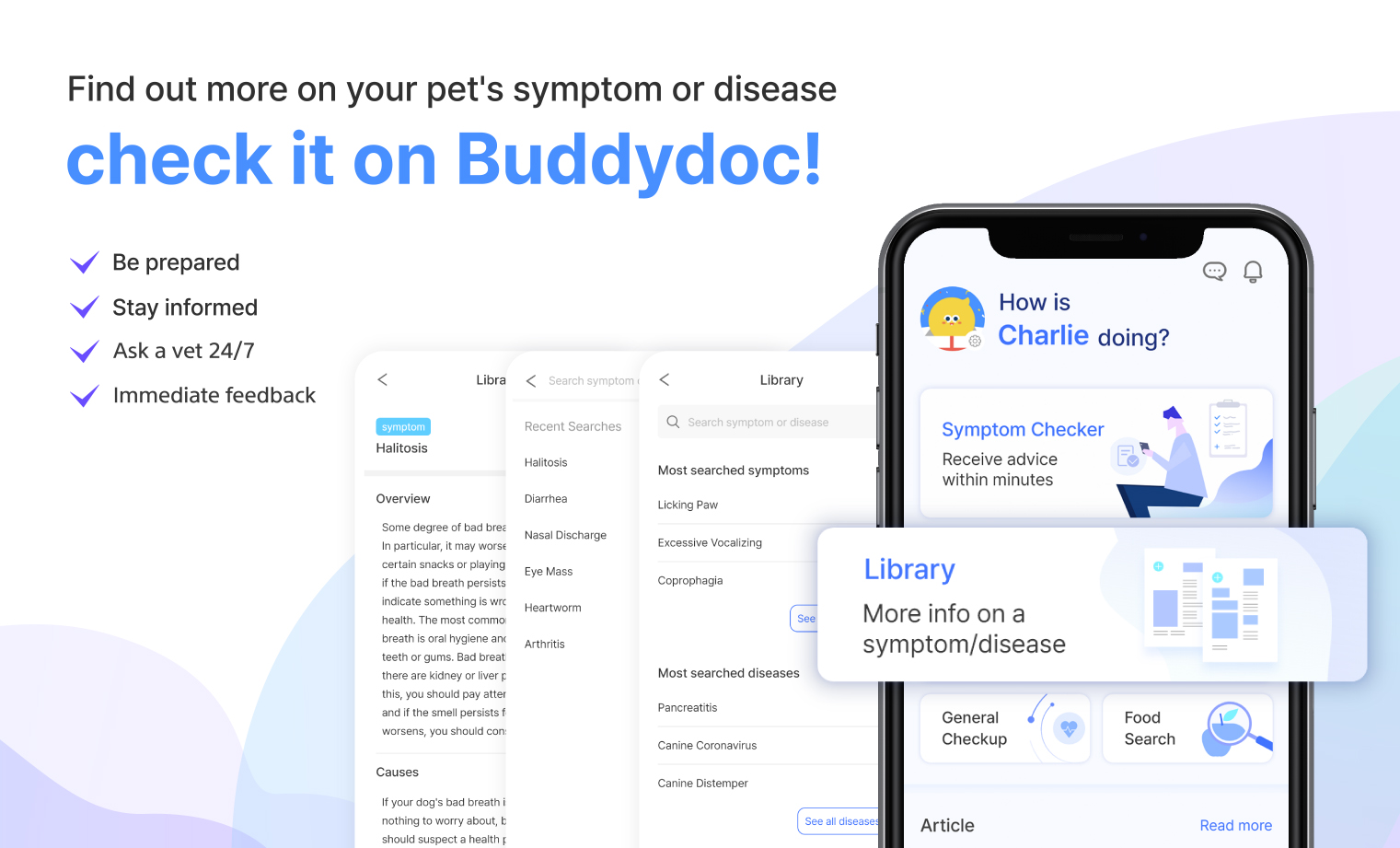DISEASES
Understanding Cushing's Disease in Dogs - Symptoms and Treatments
페이지 정보
본문

What is Cushing's disease?
Cushing's disease, medically known as hyperadrenocorticism, is a serious condition caused by excessive secretion of a hormone called cortisol from the adrenal glands. The adrenal gland is an organ located above the kidneys that produce and stores hormones necessary to sustain a healthy life. Cortisol plays a role in regulating your dog’s overall health, including metabolism, blood pressure, blood sugar levels, and inflammation, as well as regulating the immune response and relieving stress. However, too much cortisol can weaken the immune system overall, making it susceptible to other diseases and infections.
What causes Cushing’s disease in dogs?
Cushing's disease, also known as Cushing’s syndrome, is caused by an excess of cortisol secreted by the adrenal glands. Most cases (about 80 to 90%) of Cushing's syndrome are caused by tumors of the pituitary gland, and the remainder is caused by tumors of the adrenal gland. The adrenal glands are stimulated by adrenocorticotropic hormone (ACTH) which is produced by the pituitary gland. In the presence of a tumor, it causes both glands to misjudge how much hormones to produce, resulting in Cushing’s disease. Long-term or excessive use of steroids can also cause iatrogenic Cushing's syndrome.
The following are the main causes of Cushing’s disease in dogs:
-
Pituitary tumor (benign or malignant)
Excessive secretion of adrenocorticotropic hormone by the pituitary gland
-
Adrenal tumors (benign or malignant)
What are the main symptoms of Cushing’s disease in dogs?
The most common symptoms observed in dogs with Cushing’s disease typically have increased thirst, appetite, and increased urine output. However, these symptoms may appear gradually, and can be difficult to recognize that there is a problem.
Cushing's disease can present with one or more of the following symptoms:
- Increased thirst/increased urine output
- Increased appetite
- Thinning skin
- Poor haircoat
- Symmetrical hair loss
- Muscle wasting and weakness
- Potbelly
- Blackheads on skin
When to see a vet if you suspect Cushing’s disease
Symptoms of Cushing's syndrome appear gradually and can often be mistaken for general signs of aging. If you notice your pet is drinking more water than usual, their skin is beginning to thin or is easily damaged, or symmetrical hair loss, alone or in combination. These tell-tale signs offer a good enough reason to have the cause checked by a veterinarian. It is recommended to have Cushing’s disease diagnosed, or ruled out, as early as possible because the prognosis worsens and may increase the risk of other health complications. Due to excessive hormone production, issues such as developing skin calcifications, bladder stones, renal failure, high blood pressure, and diabetes can develop.
Home treatment for Cushing’s disease in dogs
Cushing's syndrome is a disease that is difficult to manage without a treatment plan and prescription administered by a veterinarian. If any of the symptoms mentioned above appear, it is recommended that you consult with your veterinarian for appropriate treatment.
How is Cushing’s disease diagnosed in Dogs?
The following procedures and exams may be performed to diagnose Cushing’s disease in your dog:
-
Basic physical exam
A medical evaluation of your pet’s history and current physical condition will be assessed. This process includes going over which symptoms, how long, and other general questions about your pet’s condition will be asked.
-
Blood test
A basic screening test using blood is performed. A complete blood count (CBC) test can check for signs of Cushing’s and prompt them to move on to a more accurate exam to determine a diagnosis.
-
Urine test
Because the specific gravity (USG) of urine is generally low in Cushing's syndrome, urine can be collected and tested. Since bladder infections or stones are often present in patients with Cushing’s, a microscopic examination and culture may be performed to evaluate them further.
If Cushing's disease is strongly suspected after a basic examination, the following advanced diagnoses are performed:
-
Hormonal screening tests
There are various testing methods, but the two most common methods for diagnosing Cushing’s disease are the ACTH stimulation test and the LDDS test. Other tests such as the HDDS test (high dexamethasone suppression) and endogenous ACTH test exist to help determine which type of Cushing’s is present.
ACTH stimulation test (adrenocorticotropic hormone)
A blood sample is taken and given an injection of the adrenocorticotropic hormone. Then a second blood sample is taken a few hours later. If the dog’s cortisol level rises slightly, the response is considered normal. However, if the cortisol levels increase and exponentially rise, Cushing’s disease can be confirmed.
LDDS test (low-dose dexamethasone suppression)
This method tests how a dog’s body responds to a synthetic version of cortisol, dexamethasone, and compares the response from a blood sample taken before and after injection. -
Diagnostic imaging
X-rays, ultrasound, CT, and MRI may be performed to confirm a tumor on the adrenal or pituitary gland.
How is Cushing’s disease treated in dogs?
Cushing's syndrome requires treatment according to the cause of the disease. If a prescription drug is the necessary treatment method, then generally monitoring the dog’s condition and reaction to the drug needs to be checked through regular blood tests.
Depending on the cause, the following are treatment methods for Cushing’s disease:
-
Pituitary gland tumor
In general, Cushing's syndrome is managed by regulating cortisol secretion through drugs (trilostane, mitotane). Periodic monitoring is necessary to prevent side effects from medications and to confirm the correct dosage. Depending on the size and location of the tumor, surgical removal may be required, but surgery on the pituitary gland is complicated and dangerous, so it is not a likely method of treatment.
-
Adrenal gland tumors
To treat adrenal tumors, it is best to remove the tumor through surgery and then perform a biopsy to determine whether it is benign or malignant.
-
Iatrogenic Cushing's disease
Steroid use should be gradually discontinued and monitored to see if Cushing's disease disappears over time.
Prognosis of Cushing's disease
Except for cases where malignant tumors are the cause, Cushing’s disease generally has a good prognosis if properly diagnosed and treated, so if symptoms are suspected, it is recommended to receive management after consultation with a veterinarian.
Can you prevent Cushing’s disease in dogs?
Prevention is usually not possible if a tumor is the cause for Cushing’s disease. However, iatrogenic Cushing's disease due to long-term use of steroids can be prevented through consultation with your veterinarian regularly to ensure the healthiest outcome.
Find out more about your dog’s condition or symptoms in the Buddydoc Library!

The Buddydoc library is filled with everything you’d want to know about each symptom and disease your pet may experience. If you would like to find out more about the causes, signs, treatments, preventions, and more for your dog’s condition. Try out the Buddydoc app and search your pet’s symptom or condition in the Buddydoc library.














